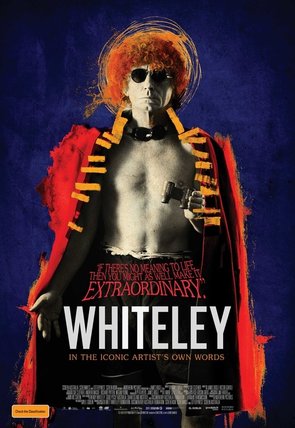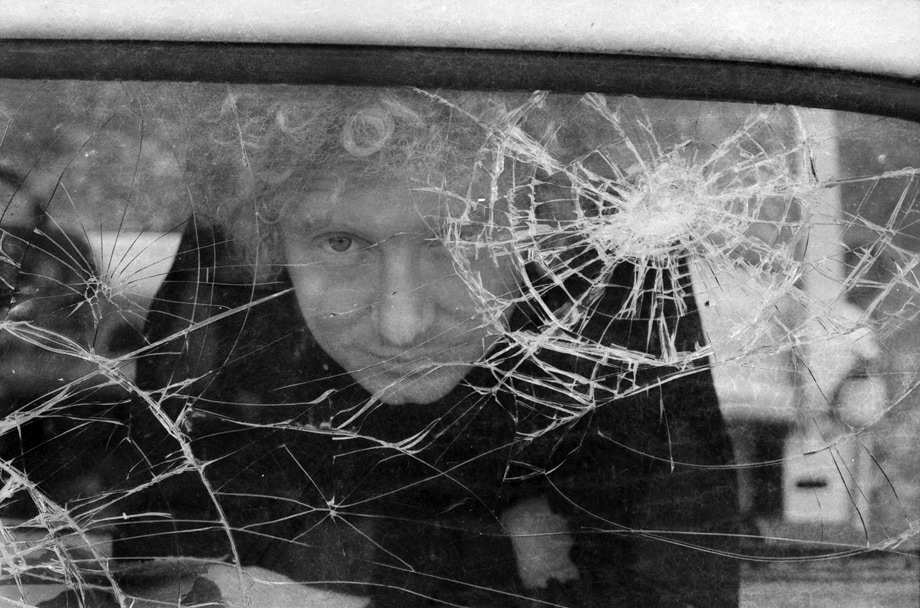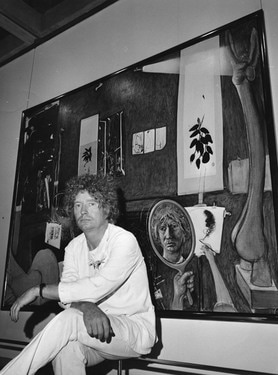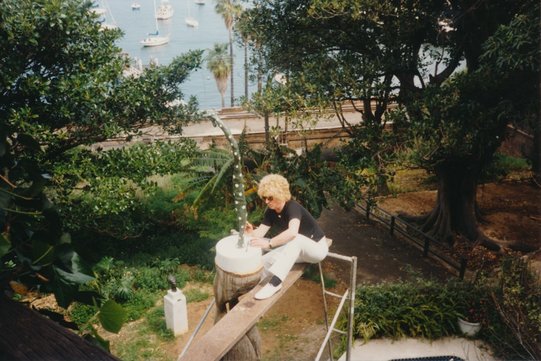Brett Whiteley – the film The caption on the poster for this film reads: “If there’s no meaning to life, then you might as well make it extraordinary. Whiteley in the iconic artist’s own words.” Brett Whiteley (1939-1992) was certainly the most public and media-celebrated Australian artist of the 20th century. Following in the footsteps of an authoritative biography on the artist by Ashleigh Wilson in 2016 comes this new feature-length film. While it is advertised as being in the artist’s own words, the director James Bogle skilfully blends rare documentary footage with actors playing the role of Whiteley as a child (Jack Barns), as a youth (Campbell Greenock) and as an adult (Andy Blaikie). The film is presented as the great love story between Brett and Wendy (the latter played by Wendy herself for recent footage and by Jessica White for earlier evocations). The story is set against the background of a spectacular and turbulent artistic career that starts in provincial Sydney, comes to an early culmination in London, where the Tate buys a major painting from the 21-year-old artist, the glitter of New York in the 1960s, where the Whiteley family lives in the penthouse of the Chelsea Hotel, and the subsequent Sydney years where reference to alcohol and drug use adds to the artist’s notoriety and popular cult-like status. Wendy was not only Brett’s lover and wife, but also his muse and the most significant model in his oeuvre from the mid-sixties through to the 1980s. Her early training at art school provided her with a degree of visual literacy, so that she was not simply the artist’s passive companion, but a knowledgeable collaborator who could share his passions in his journeys through art, his excitement and ultimately his vices. The film sits midway between a documentary and an imaginative re-evocation of the artist’s life and work. Whiteley was more opinionated, than articulate. He was constantly in the public eye giving countless interviews and making sense of the world from his own very idiosyncratic perspective. Art was his real language of expression and here he found a creative freedom in his graphics, huge sprawling paintings, sculptures and installations. The single most important achievement of the film is the exposure it provides to Whiteley’s art, including actuality footage of the artist at work and explaining his creations, but most significantly images of the artworks themselves. The device constantly adopted throughout the film of zooming in on the detail in the work and pausing at length on lush passages of paint or the fluid sensuous line that only hints at form, is effective and at times spectacular. Whiteley is an artist whose colourful biography frequently obscures the seriousness and consistency of his work. He may have produced much painting that was poor and uneven and possibly designed to feed his and Wendy’s drug addiction. These paintings were aimed at art collectors who collected with their ears rather than their eyes and on hearing the magic name of Whiteley opened their wallets like obedient Pavlovian dogs. At his best, Whiteley was brilliant and a major achievement of the film is that it focuses on Whiteley at his best. A viewing of it reminds us that that there is substance in Whiteley’s art and that at times it was terrific. A film of this nature does invariably raise the question whether Whiteley was a completely autobiographic artist. One could argue that Vincent van Gogh, for example, was an obsessively autobiographic artist, where his correspondence with his brother Theo has provided us with a vital clue as to how to interpret his paintings, both in terms of their imagery as well as their emotional and spiritual content. I think that this is equally true in the case of Whiteley. When in Italy or the South of France, London, New York, Fiji and Sydney, the surrounding environment to some extent determined not only what he painted, but also how he painted. In London, it may have been the swinging sixties, but when he came to paint the Bathroom series or the Christie series, it reflected not only the physicality of London, but also the impact of Francis Bacon and the exposure to the art of Pierre Bonnard. In New York, Whiteley responded both to the excitement and violence of the place in his American Dream (1968-69), a masterwork that drained him of his energy to the point of physical and spiritual exhaustion. While he grappled with American Pop Art and such political artists as Leon Golub, he was also responding to the reports of daily violence in the Vietnam War and the assassinations of President Kennedy and Martin Luther King. This film to some extent attempts to bring together cause and effect in Whiteley’s art, lucid and incisive in places such as when discussing his life in New York, less satisfactory in its treatment of Whiteley in Sydney at Lavender Bay. Here we are introduced to the physicality of the place, but little is said of the surrounding artistic milieu. Although the mentorship of Lloyd Rees is discussed at some length, other artists surrounding Whiteley, including Martin Sharp, are passed over in silence. Whiteley was the most sociable of artists and a larger-than-life figure in the Sydney art scene. James Bogle’s Whiteley is a seductively attractive film that offers us an unusual insight into the life and art of the creative and troubled maverick in Australian art who held our attention for over three decades. With time, we will forget about the drugs and the lifestyle and will come to focus on Whiteley’s art and its lasting legacy. Whiteley: Directed by James Bogle A Northern Pictures Production distributed by Transmission Films
7 Comments
|
GRISHIN'S ART BLOG
Sasha Grishin AM, FAHA is the author of more than 25 books on art, including Australian Art: A History, and has served as the art critic for The Canberra Times for forty years. He is an Emeritus Professor at the Australian National University, Canberra; Guest Curator at the National Gallery of Victoria, Melbourne; and Honorary Principal Fellow, Faculty of Arts, at the University of Melbourne. Archives
June 2024
Categories
Keep up-to-date with Sasha Grishin's blog with the RSS feed.
RSS offers ease of access and ensures your privacy, as you do not need to subscribe with an email address. Click here to download a free feed reader |





 RSS Feed
RSS Feed